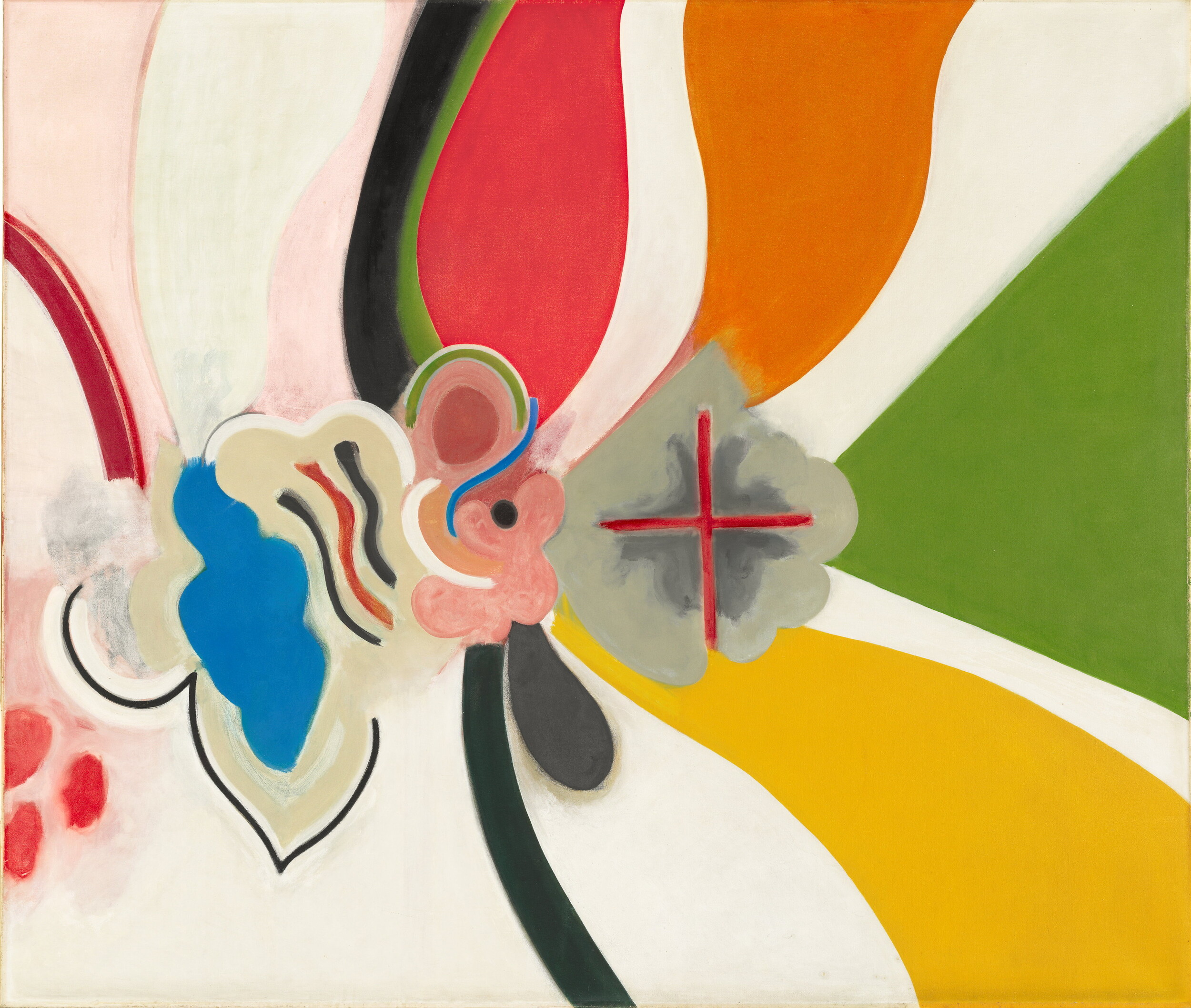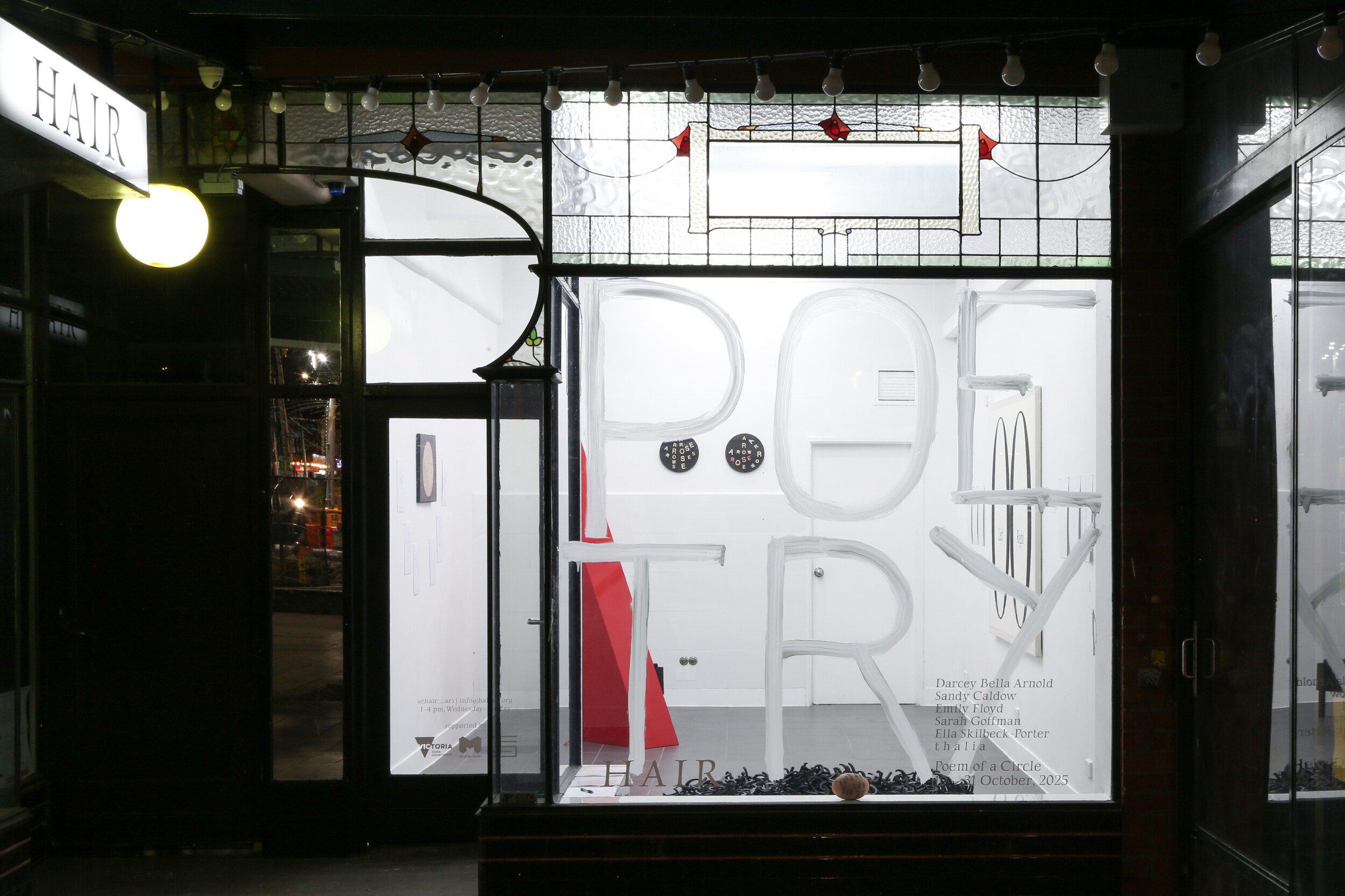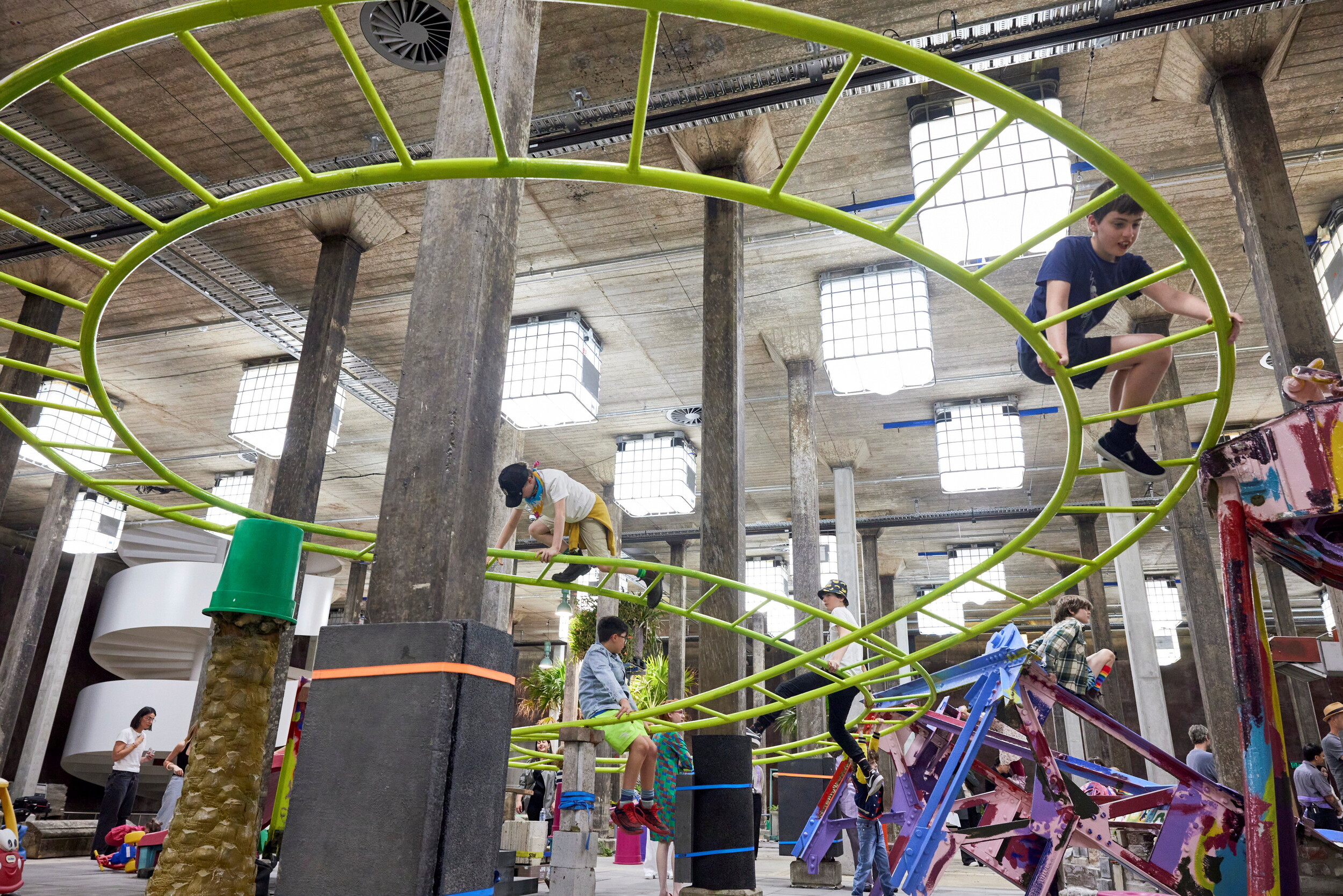Installation view of The Veil, Buxton Contemporary, the University of Melbourne. Featuring Hayley Millar Baker, Eternity the Butterfly, 2025. Michael Buxton Collection, the University of Melbourne Art Collection. Photography by Christian Capurro
The Veil
Anna Parlane
Risking an adjective that is perennially taboo in leftist art circles, I’m just going to come out and declare that Buxton Contemporary’s current show, The Veil, is essentially conservative. I mean by this that it is primarily concerned with cultural continuity, and how the past is preserved over time. The exhibition also explores a model of reality that is essentially religious, in that an ancestral, supernatural or otherwise transcendental dimension subtending everyday lived experience is taken as given. Curated by Hannah Presley (Marringarr) with Isabella Hone-Saunders, the show presents works by six artists who explore the interpenetration of the otherworldly and the everyday. The titular metaphor of the veil is drawn from the beautiful Celtic idea of “thin places”: sacred places where the veil between worlds is unusually flimsy.
The idea of the veil as a boundary between our reality and another one is expanded and articulated with various degrees of literalness by the artworks in the show. All either textile works or photo-media, they deploy permeable barriers or screens in the form of either photographic film or woven, stitched or knotted fibre. This also extends to the exhibition’s design. In addition to the theatricality of dark coloured walls and moody lighting, dramatic sheer floor-to-ceiling curtains operate as room dividers separating the moving image works from the installations of two-dimensional and object-based pieces. However, the fact that light and sound bleed freely through these sheer barriers reinforces the impression of barely contained natural or supernatural forces seeping in from elsewhere.
The curators have skilfully constructed an explicit narrative about the everyday practices of negotiating and managing ancestral power. Underpinning this, the show also tells another story—one that is less visible—about the importance of relationship-maintenance to artistic practice.
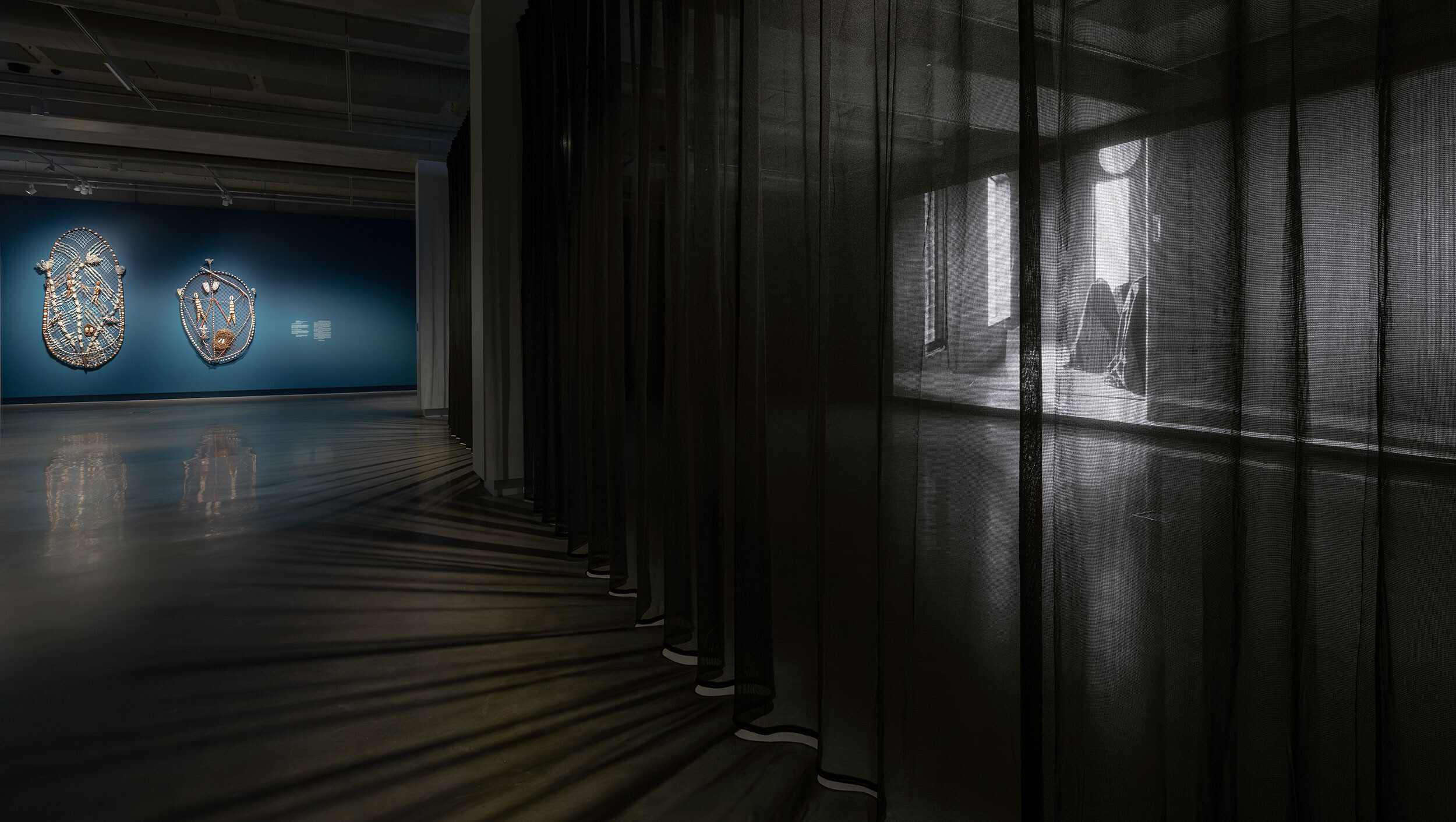
Installation view of The Veil, Buxton Contemporary, the University of Melbourne. Featuring Lena Yarinkura, Ngalmudj and Two Sisters, 2025; Hayley Millar Baker, Eternity the Butterfly, 2025. Photography by Christian Capurro
The exhibition showcases several recent acquisitions to the University of Melbourne collection: works by Hayley Millar Baker (Gunditjmara, Djabwurrung, Nira-Bulok Taungurung), Glenda Nicholls (Waddi Waddi, Yorta Yorta, Ngarrindjeri), Lisa Waup (Gunditjmara, Torres Strait Islander), and Lena Yarinkura (Kune) were all acquired between 2024 and 2025. Significant floor space is given over to Millar Baker’s ethereal trilogy of short films, which extends over both levels and in many ways sets the tone of the show. The final work in this series, Eternity the Butterfly (2025), was acquired for the collection this year and is presented at full cinema scale in the large ground floor gallery. However, Lisa Waup’s installation Holding Country (2024) is the first work that viewers encounter, and it establishes some important grounding principles that anchor the exhibition’s more flagrantly spooky works.
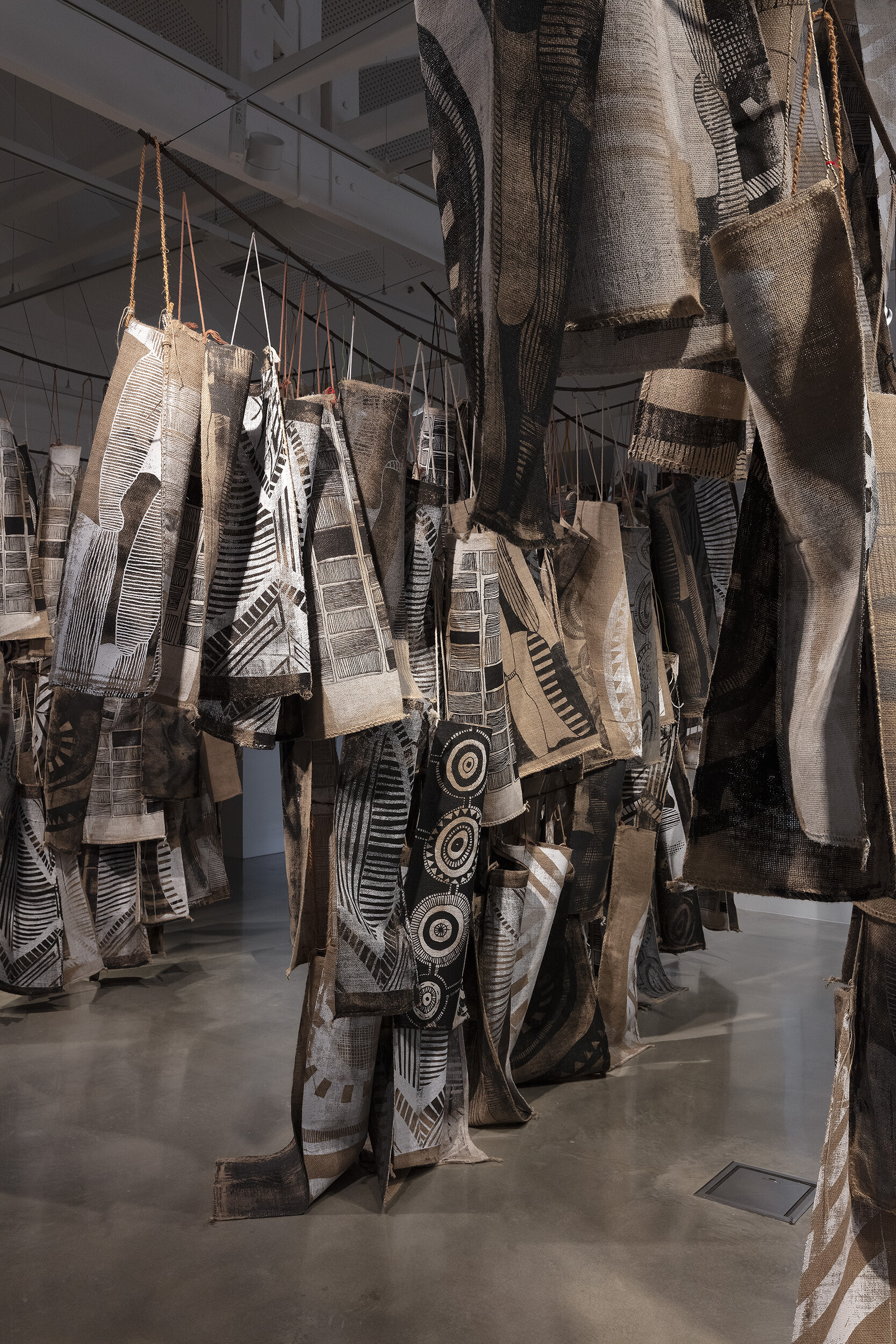
Installation view of The Veil, Buxton Contemporary, the University of Melbourne. Featuring Lisa Waup, Holding Country, 2024. The University of Melbourne Art Collection. Photography by Christian Capurro
Waup’s installation of jute bags resembles a storage room. Screenprinted with her own drawn markings and designs, the bags hang from a series of jerry-rigged hooks and railings cobbled together from found construction materials, sticks and the sorts of bits and pieces that get washed up by the tide. The work recalls the artist’s experience of a major flood and the sandbags her community used to hold back the water, which are here marked up with designs referring to family, storytelling, and Country. Evoking both uncontainable, overwhelming natural forces and the practical and cultural means of managing and mitigating them, Holding Country also grounds the exhibition in contemporary climate politics, and First Nations’ grief over damage to Country.
These real-world references might seem counterintuitive in a show that is supposedly devoted to the supernatural, but they are in line with Presley’s clear-eyed, pragmatic and responsive approach to curatorial practice. As an artist-led curator who frequently develops long-term working relationships with artists, Presley’s approach honours the actual everyday significance of ancestral or supernatural entities in the lives of the exhibiting artists, even if—as in Waup’s case—these may not be immediately obvious to others. Despite the exhibition’s title, therefore, spiritual experience is treated here with disarming candour rather than mystification, as a routine part of the fabric of everyday life.
The relational scaffolding holding Presley’s curatorial practice is evident in the selection of artists and works. Glenda Nicholls, for example, has worked with Presley for over ten years. Her work The Reflection Net (2024) continues Waup’s theme of the spiritual and practical management of waterways. Installed in the stairwell between Buxton’s two levels, Nicholls’ intricately knotted net describes the dreamlike reflections on the surface of the Milloo (Murray River), and also continues practices of net-making, weaving, and feather craft passed down through generations of women in her family. The work also revises and reworks Nicholls’ earlier Miwi Milloo (2020), which was commissioned by Presley in her former role as Curator of Indigenous Art at the NGV, and exhibited in the 2021 Triennial. It also implicitly recalls a pivotal early net piece in Nicholls’ practice, Ochre Net (2012), which was awarded two prestigious prizes when it was shown in the 2012 Victorian Indigenous Artists Awards, also curated by Presley.
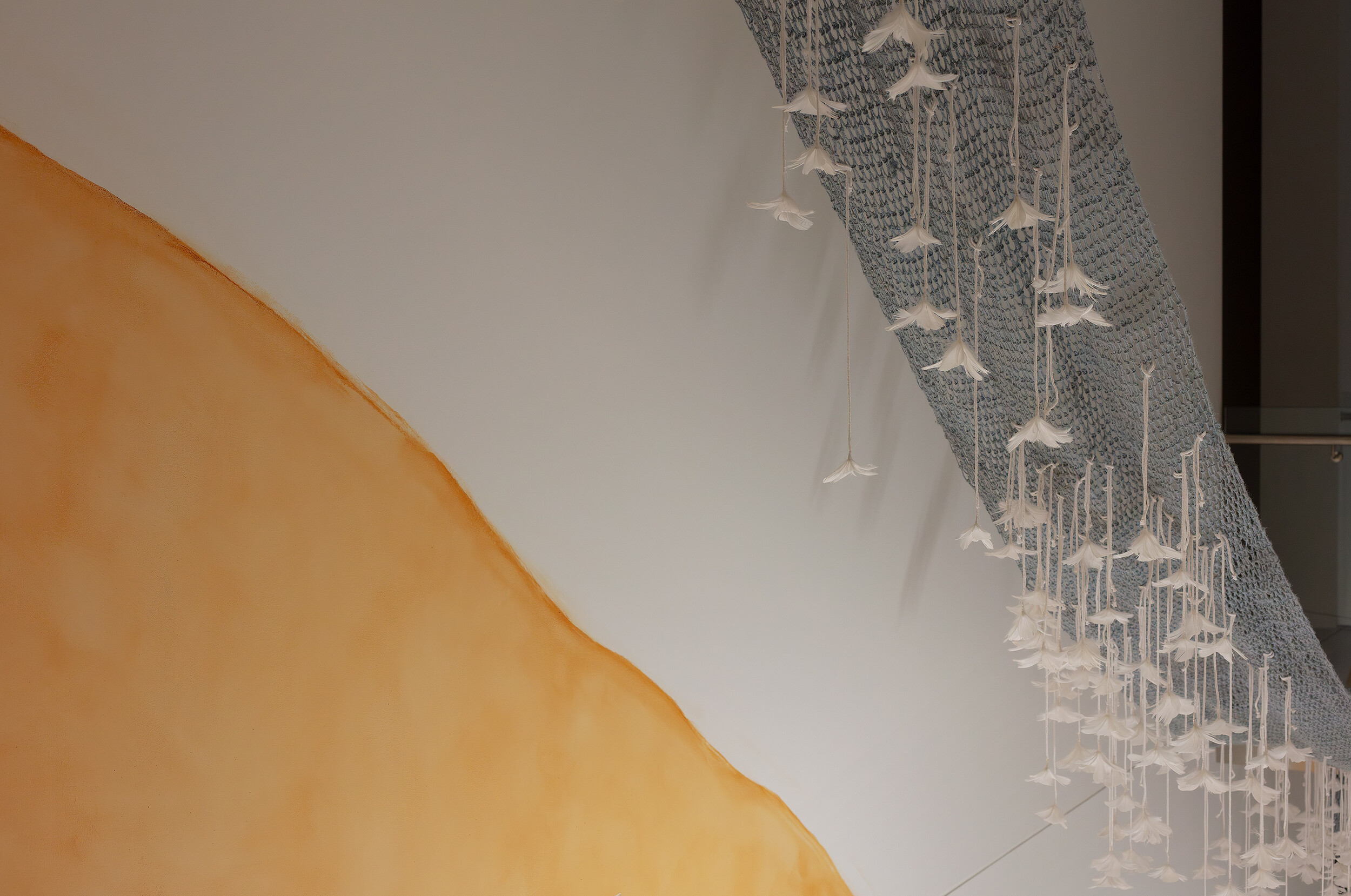
Installation view of The Veil, Buxton Contemporary, the University of Melbourne. Featuring Glenda Nicholls, The Reflection Net, 2024. The University of Melbourne Art Collection. Photography by Christian Capurro
Other works in the show have similarly emerged out of curator-artist relationships that extend beyond the short-term temporality of the exhibition. The numerous works by Hannah Gartside almost form a mini-retrospective in the upstairs gallery, and include a piece originally exhibited at Sydney’s MCA as part of Presley’s 2021 Primavera. The inclusion of the only international artist in the show, the Polish Aneta Grzeszykowska, who at first glance appears an incongruous choice alongside predominantly local artists, makes more sense when you learn that Presley first encountered her work at the Venice Biennale, which she visited together with Hayley Millar Baker.
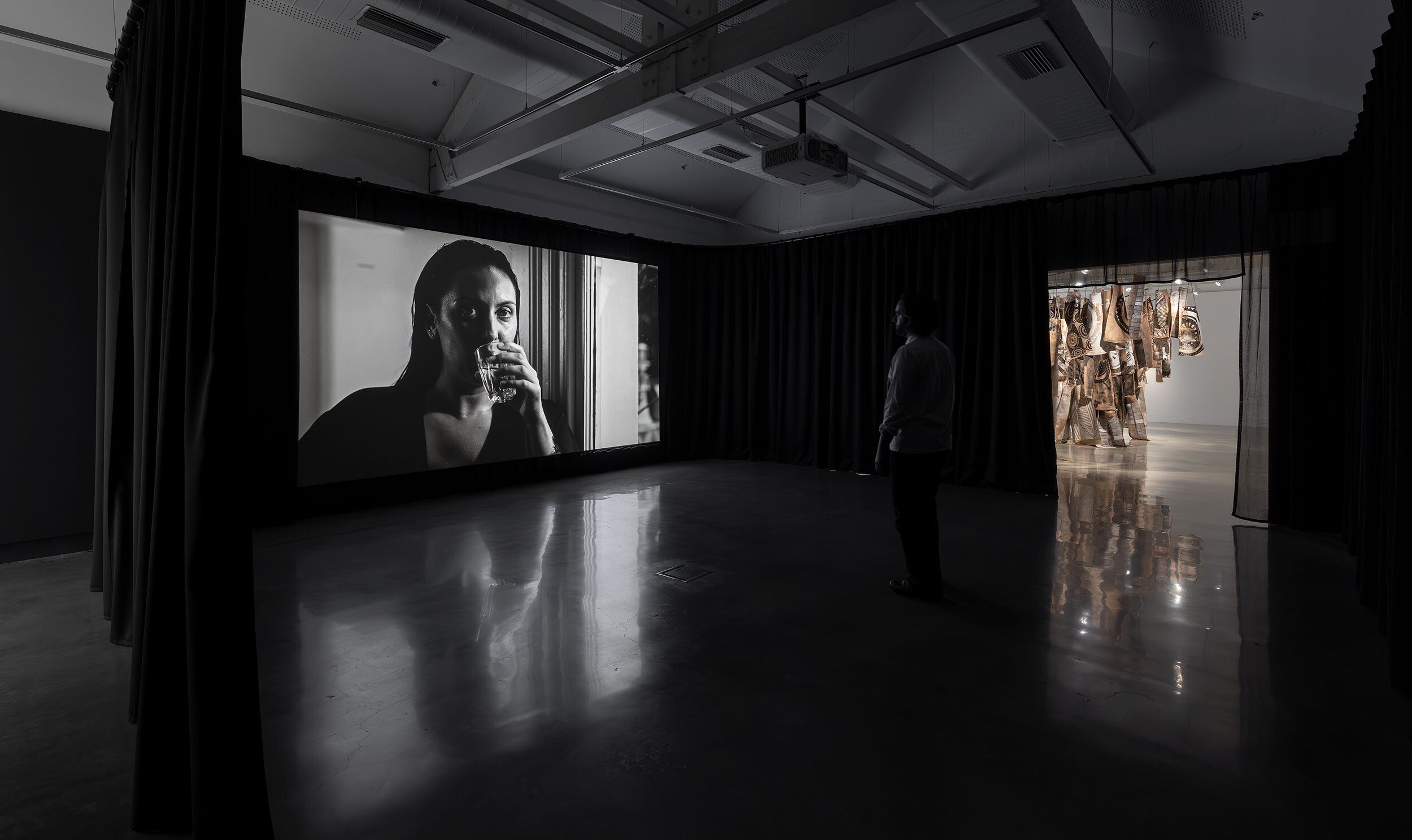
Installation view of The Veil, Buxton Contemporary, the University of Melbourne. Featuring Hayley Millar Baker, Nyctinasty, 2021; Lisa Waup, Holding Country, 2024. Photography by Christian Capurro
Millar Baker’s film trilogy uses the tropes and aesthetic of golden-age Hollywood cinema to depict an eerie twilight world of mysterious rituals. The inaugural work in the series, Nyctinasty (2021), was commissioned by Hetti Perkins (Arrernte, Kalkadoon) for Ceremony, the 2022 National Indigenous Art Triennial. The term “nyctinasty” describes the action of plants closing their flowers at night, and Millar Baker’s film shows its protagonist tending a fire and then concocting and applying charcoal paste to her skin in an enigmatic night-time preparation. The artist’s delight in the conventions of classic cinematic horror is evident across all three films: all are shot in gorgeous warm-toned black-and-white; all feature solitary female protagonists wearing slinky nightwear in elegant modernist architectural settings; all linger on spare geometric compositions of raking light and dramatic cast shadows. Millar Baker also liberally deploys Hitchcockian techniques to create an uneasy mood—intimate, but also evocative of a sinister, voyeuristic and hovering presence—which in Nyctinasty builds to an excellent final jump scare.
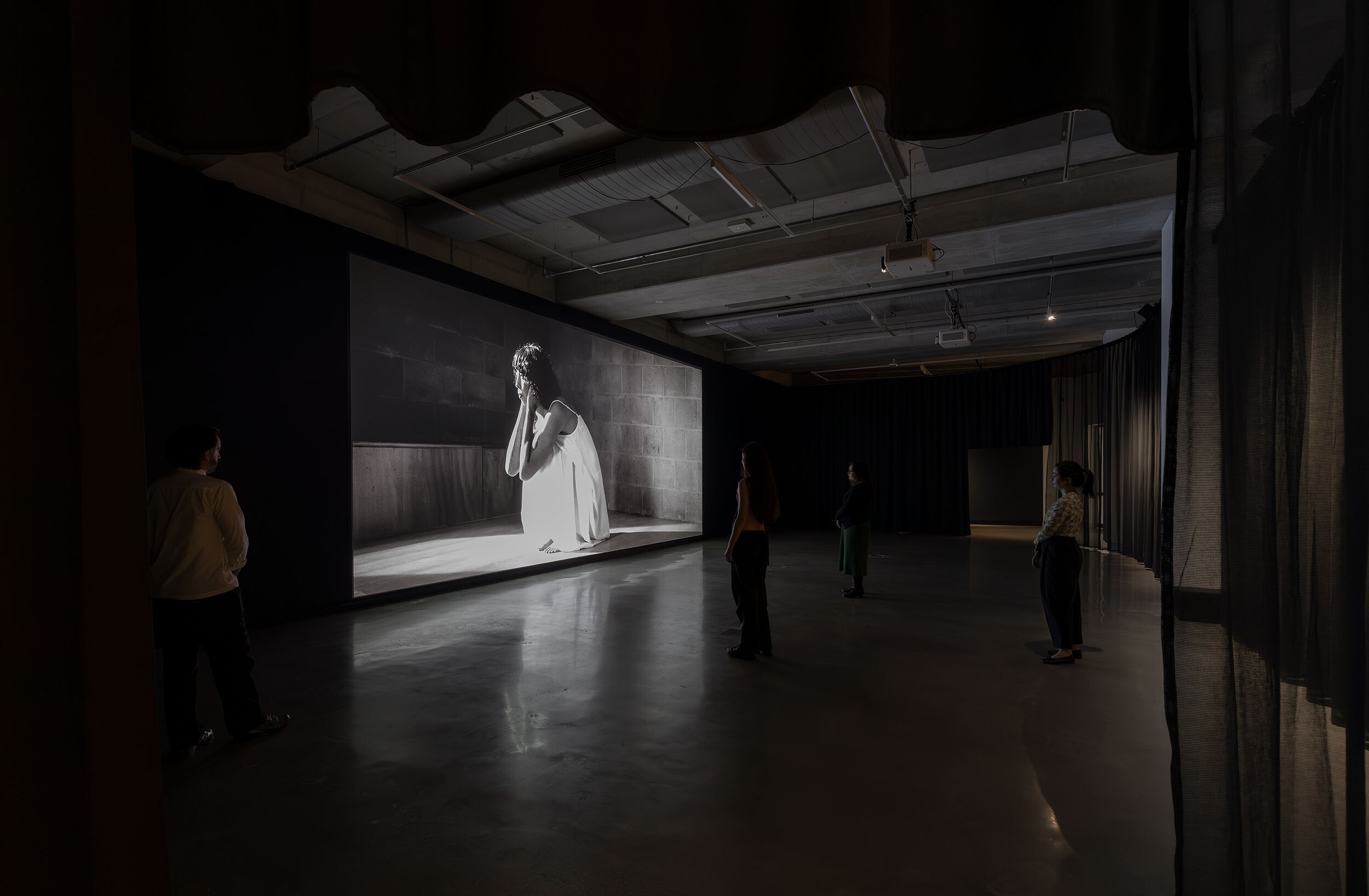
Installation view of The Veil, Buxton Contemporary, the University of Melbourne. Featuring Hayley Millar Baker, Eternity the Butterfly, 2025. Michael Buxton Collection, the University of Melbourne Art Collection. Photography by Christian Capurro
The films’ soundtracks, which echo through the entire exhibition, are key to their atmospheric quality. The latest work in the series, Eternity the Butterfly, combines the breath of its protagonist, ASMR whispers in language, and an incredible sonic composition of native bird calls. As the film’s protagonist—Eternity—undertakes rituals to call up the spirits of her ancestors, the soundtrack ebbs and flows in rhythm with the arrival and departure of the supernatural entities she summons. The bird calls swell into a cacophony, indicating that the veil has been pierced and the ancestors are present, then subside when Eternity disconnects from her supernatural group call and closes the portal. In all three films, the otherworldly forces evoked feel potentially threatening, but are skilfully managed by the characters using ritual practice.
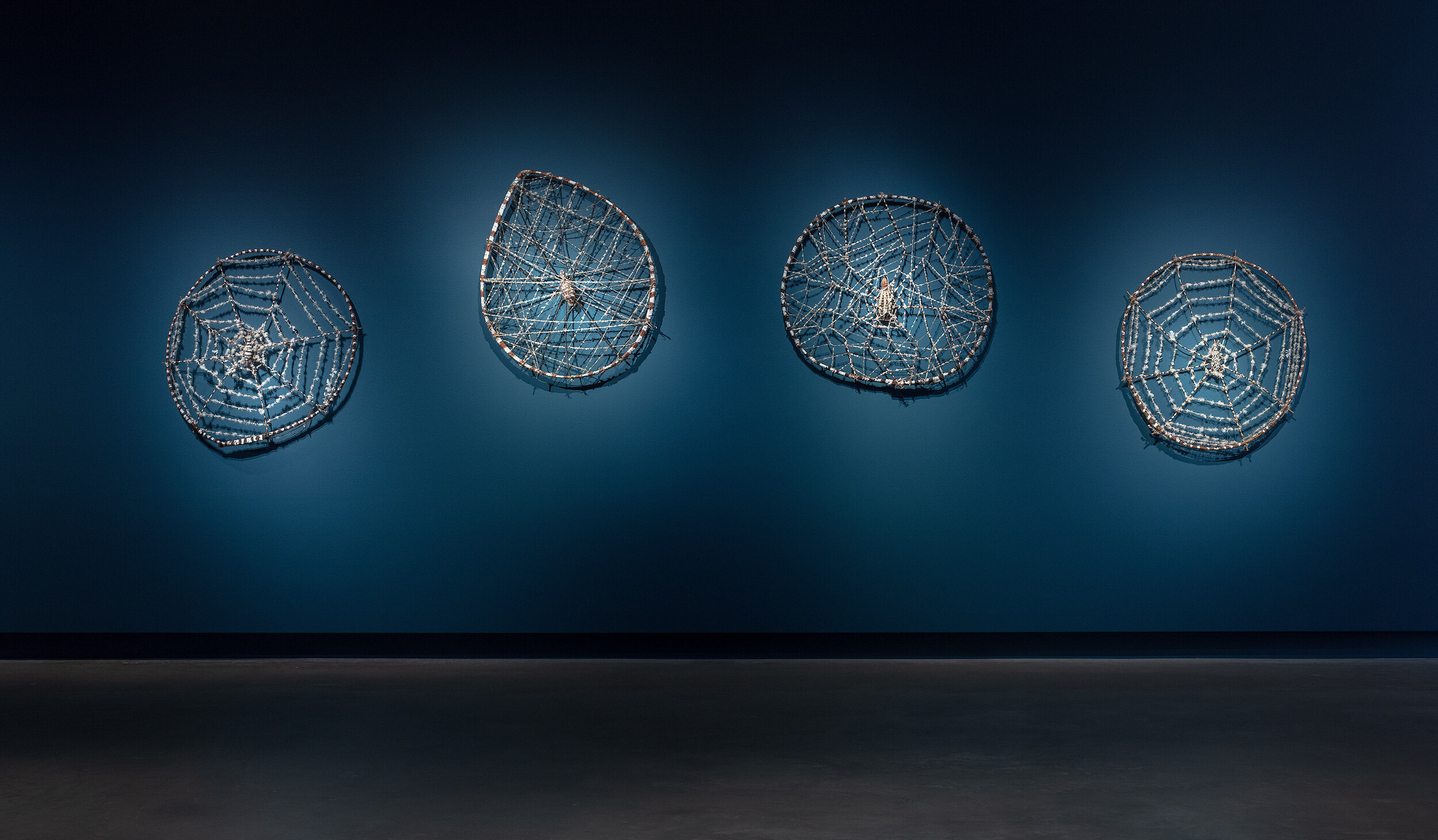
Installation view of The Veil, Buxton Contemporary, the University of Melbourne. Featuring Lena Yarinkura, Karrh (Spider), 2025. Photography by Christian Capurro
Like Millar Baker’s films, Lena Yarinkura’s woven fibre works operate in the genre of supernatural horror; however, Yarinkura’s protagonists are less adept at keeping the ancestors on side. Ngalmudj and Two Sisters (2025) is both a moralising tale and a horror story about a pair of sisters who break protocol while out hunting. As a consequence of their breach, penance is exacted on the sisters by Ngalmudj (the rainbow serpent) who appears in Yarinkura’s work twice, first in disguise as a black-and-white dog and second as an enormous snake that encircles the whole composition with his body. The two sisters in the story meet an untimely end, drowned in a billabong by Ngalmudj as punishment for their crime. This fearful outcome—a watery immersion enacted by powerful and vengeful ancestral spirits—is precisely the terrifying consequence of neglecting our cultural and spiritual responsibilities that Waup’s marked-up sand bags in Holding Country are trying to guard against.
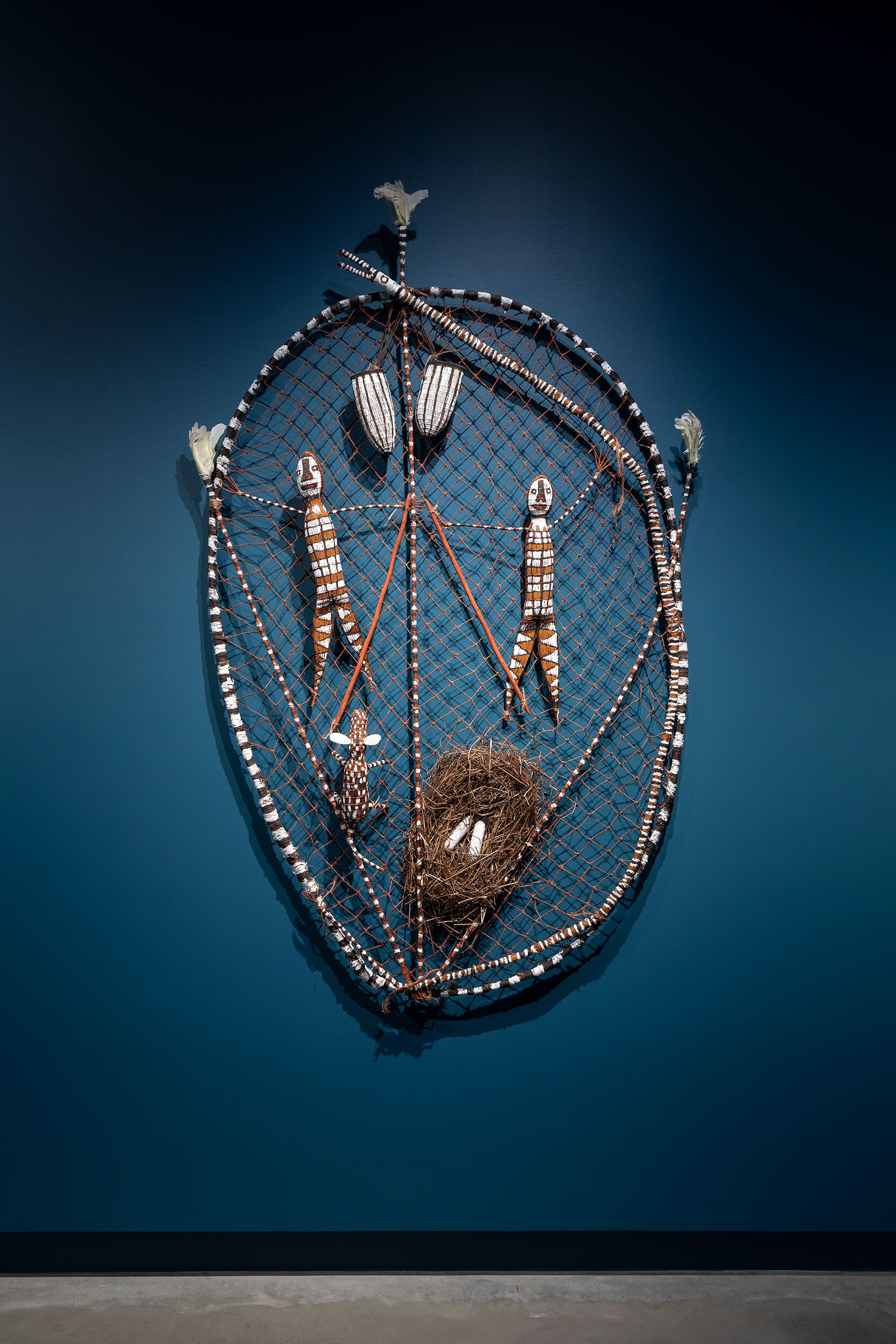
Installation view of The Veil, Buxton Contemporary, the University of Melbourne. Featuring Lena Yarinkura, Ngalmudj and Two Sisters, 2025. The University of Melbourne Art Collection. Photography by Christian Capurro
The exhibition’s morbid themes and high theatricality reach a climax with the work of Hannah Gartside in the upstairs gallery. Trained in fashion design, Gartside’s professional background as a costumier for classical ballet productions is evident in the virtuoso stitching of her textile pieces. Her works are united by their pronounced interest in the aesthetics of the Victorian occult: Floating Prism (2016, re-worked 2025) looks like a levitating lace tablecloth at the conclusion of an unusually successful séance, and the spinning kinetic sculpture Sarah (2020) periodically comes to life, having channelled the spirit of fin de siècle actor Sarah Bernhardt. Gartside’s work advances the curatorial argument for the broad cross-cultural relevance of efforts to commune with the dead. The exhibition highlights similarities between her Western occultism and the dark drama of Yarinkura’s work, for example, without diminishing the cultural specificity of their articulation.
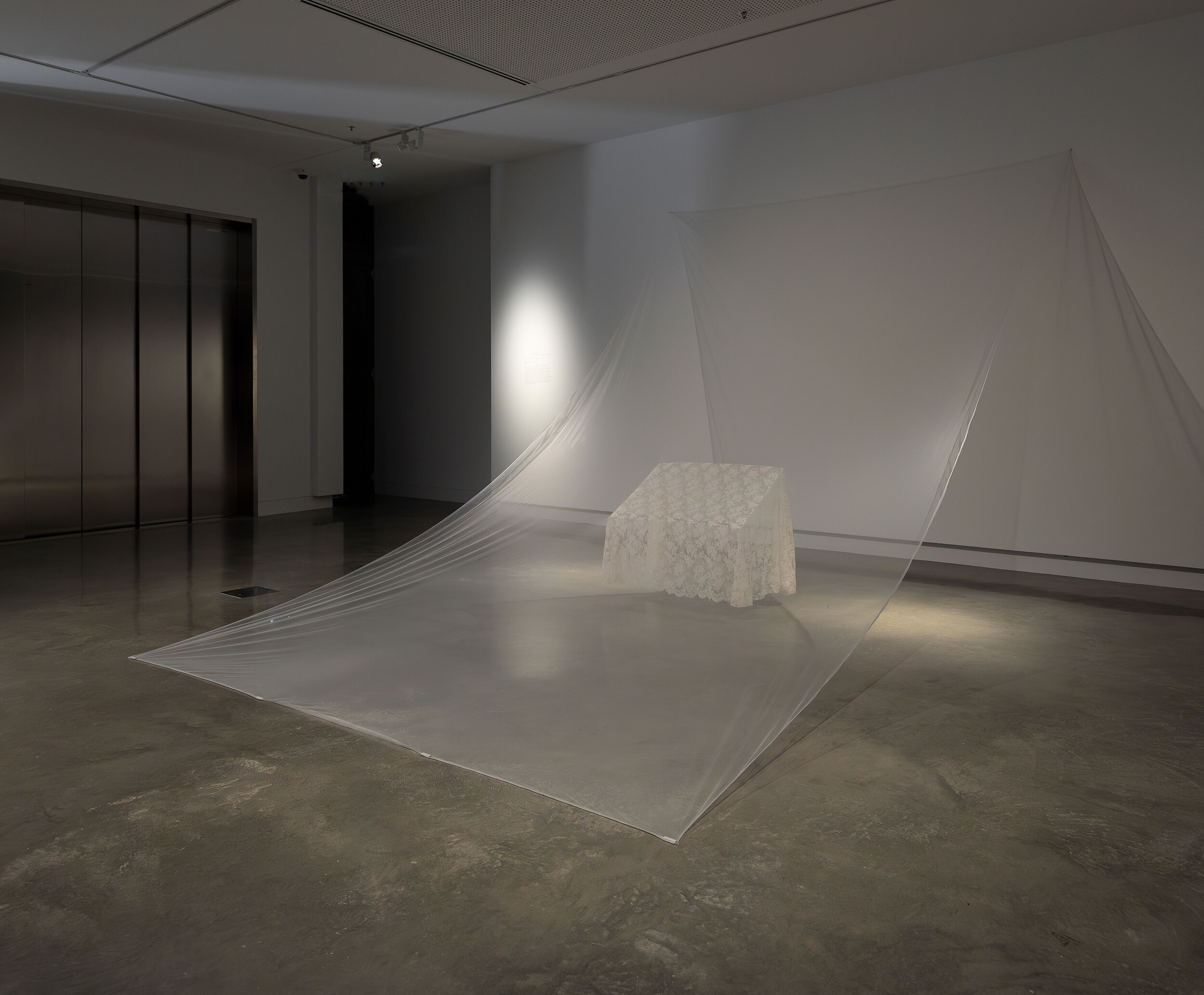
Installation view of The Veil, Buxton Contemporary, the University of Melbourne. Featuring Hannah Gartside, Floating Prism, 2016 (re-worked 2025). Photography by Christian Capurro
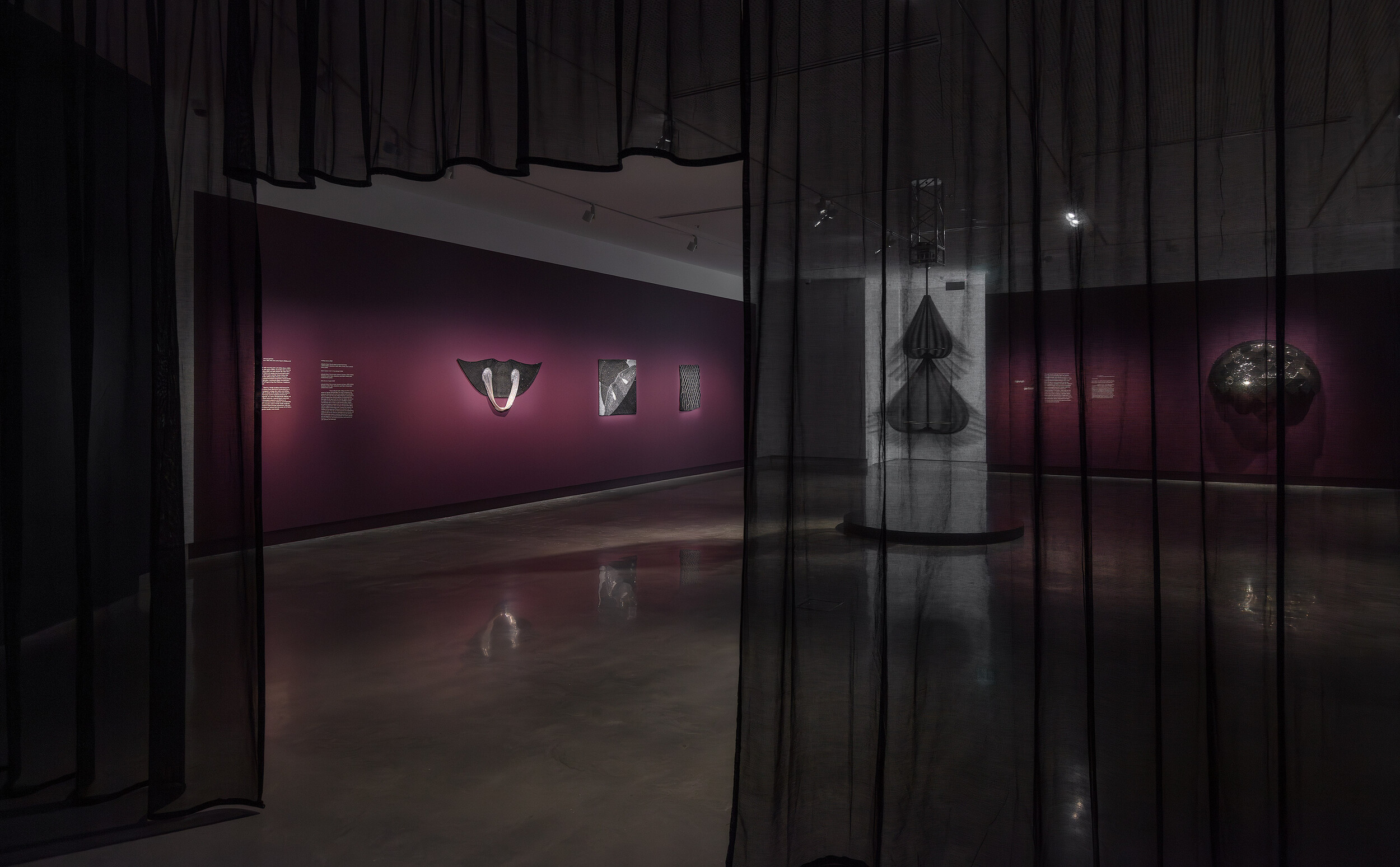
Installation view of The Veil, Buxton Contemporary, the University of Melbourne. Featuring Hannah Gartside, Returning, 2025, Sarah, 2020, and Floating Prism, 2016 (re-worked 2025). Photography by Christian Capurro
However, I was less interested in Gartside’s flair for gothic melodrama than I was in her sensitive attention to the histories of the found fabrics she uses. Constructed from white bridal tulle, Floating Prism might initially seem like an overly literal interpretation of the phrase “the veil,” but it is in fact made from a vintage wedding dress that Gartside inherited from a family friend. Sarah, similarly, was constructed from fabrics with strong personal and emotional significance, including a black nineteenth-century silk satin mourning skirt. Such textiles help to mark our transition through significant life events, and—in the case of the mourning skirt—the rituals and practices of care that ease our passage into death.
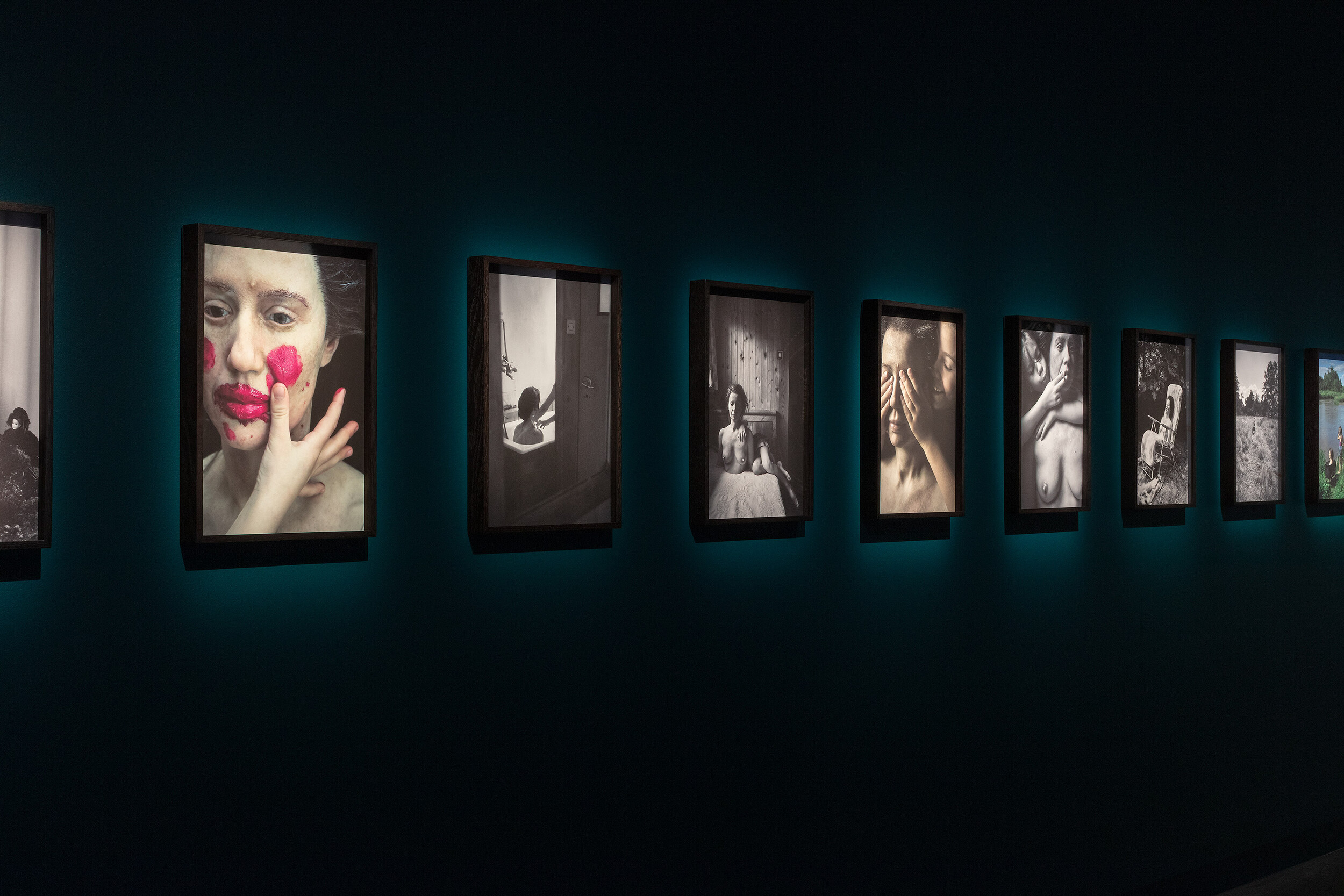
Installation view of The Veil, Buxton Contemporary, the University of Melbourne. Featuring Aneta Grzeszykowska, Mama, 2018. Photography by Christian Capurro
This, I think, is the exhibition’s key insight: the supernatural practices evoked by the artists are a means of maintaining our relationships with those on the other side of the veil. The fact that this crucial task of relationship maintenance involves both work and care is made explicit in Mama (2018), the photographic series by Polish artist Aneta Grzeszykowska. The series documents Grzeszykowska’s daughter Franciszka’s encounter with a sculptural self-portrait her mother had made for an earlier project. A bust made from silicone, the sculpture is a hyperrealistic representation of Grzeszykowska’s head, face and chest, which is unnervingly truncated at the level of her rib cage. Having come across this incredibly creepy object in her mother’s studio, Franciszka proceeded to play with, wash, care for and generally hang out with the bust as if it were a baby doll. The mother-daughter relationship of care is inverted and becomes uncanny as Franciszka’s nurturing actions begin to resemble the care shown by the living to the inert bodies of the dead.
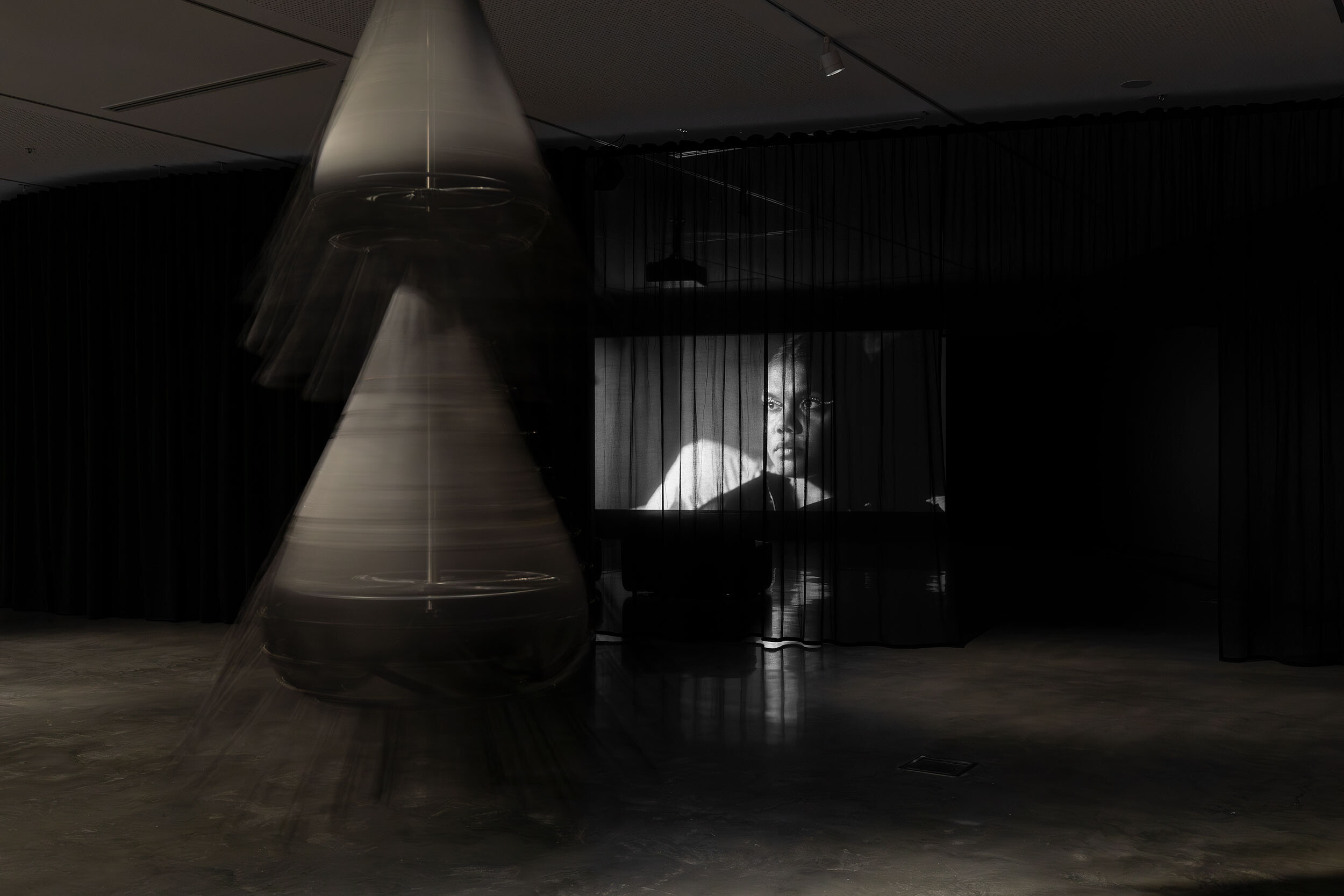
Installation view of The Veil, Buxton Contemporary, the University of Melbourne. Featuring Hannah Gartside, Sarah, 2021; Hayley Millar Baker, The Umbra, 2023. Photography by Christian Capurro
Cultural responsibility crosses generational lines, and artistic practice similarly extends beyond the brief time of a single exhibition. In both cases, the practice continues across temporal breaks, and in both cases it is supported by the relational ties that bind together community and family. These two themes come together most obviously in Grzeszykowska’s Mama, which is about intergenerational relationships between people, but also refers to the ways that art practices develop over time, showing how the residue of an older work can take on new life and meaning in the context of a new series. Long-running artist-curator relationships like that of Presley and Nicholls also acknowledge and support this durational reality of artistic practice. Like Grzeszykowska’s work, Nicholls’ The Reflection Net demonstrates both the labour and care involved in doing right by your ancestors and your community, suggesting that her knotted threads might be better understood as a connective structure linking different times and different generations, rather than a barrier.
Anna Parlane is a writer and academic in Naarm, Melbourne.
